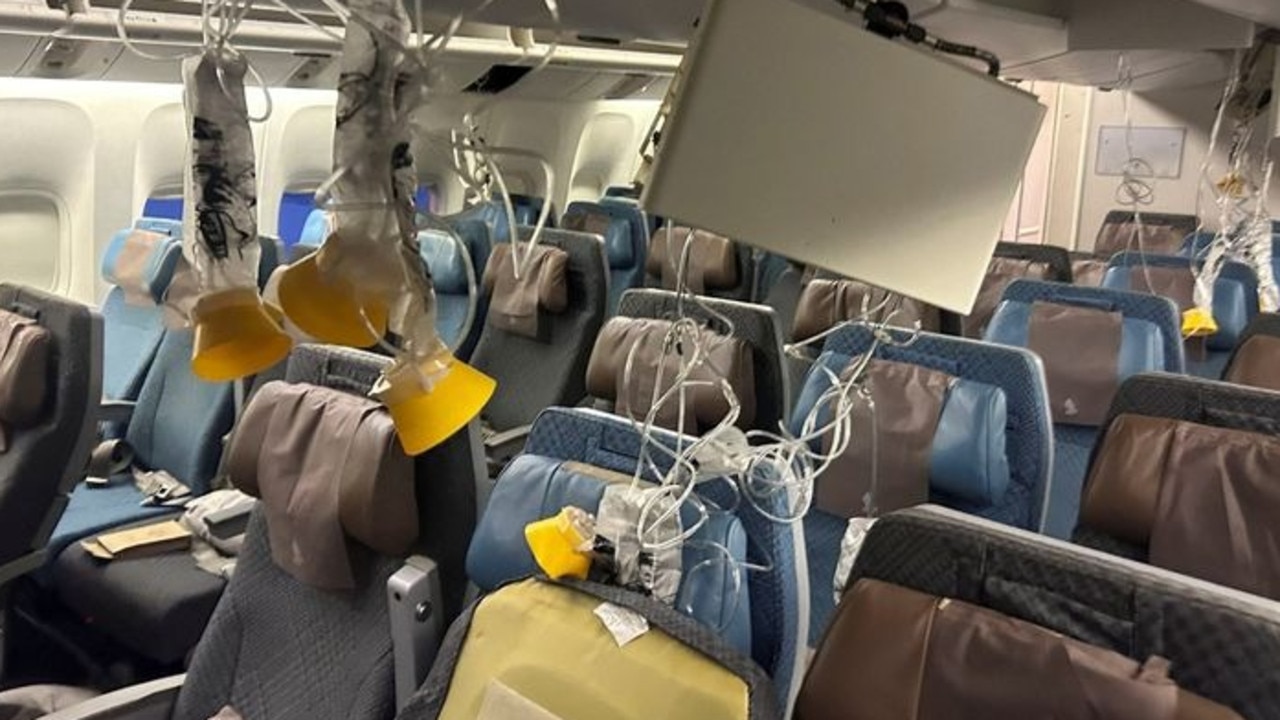Aussie’s Singapore Airlines turbulence horror at 37,000ft
An Australian passenger on Singapore Airlines flight SQ321 has described the terrifying moment she was flung to the ceiling of the Boeing 777-300ER while she was sleeping.
Business
Don't miss out on the headlines from Business. Followed categories will be added to My News.
An Australian passenger on Singapore Airlines flight SQ321 has described the terrifying moment she was flung to the ceiling of the Boeing 777-300ER while she was sleeping and crashing back to the floor during violent turbulence that left one passenger dead and dozens seriously injured.
The drama that engulfed the Singapore Airlines flight from London to Singapore has shone a light on the issue of severe turbulence and the sometimes deadly consequences.
Those injured included eight Australians. The passenger who died was identified as Geoffrey Kitchen, a 73-year-old musical theatre director from England.
The pilots were forced to divert to Bangkok, where dozens of paramedics met the flight, assessing about 70 people.
Singapore’s Transport Safety Investigation Bureau and Ministry of Transport announced an investigation, examining what warning pilots had of the turbulence, which may have been associated with developing thunderstorms.
Concerns were also raised about the relatively rare phenomenon known as clear air turbulence caused in the jet stream by a meeting of air masses moving at different speeds.
Passengers said seatbelt signs came on just moments before the plane hit turbulence while cruising at 37,000ft. With a breakfast service under way at the time, food trays, cutlery, cups and phones were catapulted through the cabins. Speaking from Bangkok’s Samitivej Srinakarin Hospital, Teandra Tukhunen described what happened. The 30-year-old from Melbourne told a UK publication she was asleep when she was suddenly “thrown to the roof and then to the floor”.

Ms Tukhunen said she didn’t have time to put on her seatbelt before she was “flung to the roof”.
She said the turbulence was over in a “couple of seconds” but it was enough to shock everyone.
Australian and International Pilots Association vice-president Mark Hofmeyer said the sort of movement suggested the turbulence was the result of thunderstorms rather than clear air.
“It looks like it’s gone up at about 1400 feet a minute for a split second and then it’s gone down at about 1800 feet a minute, so an updraft followed by a downdraft which is more typically associated with thunderstorm activity,” he said. “Occasionally you can give a storm a wide berth and you still get bumps.”
AIPA safety and technical director Steve Cornell said some forms of turbulence could be detected in advance, but not all.

“The radar systems that aircraft have detect moisture contained in clouds and thunderstorms and that gives us the ability to see those build-ups, and we can deviate around them,” said Captain Cornell, a Boeing 737 pilot who used to fly 777s. “Clear air turbulence is not associated with cloud or moisture, therefore it’s undetectable by radar systems.”
Aviation lawyer Peter Carter said the experience of a sudden drop in altitude was often traumatising, with clients describing it as the most terrifying moment of their lives. “A plane can drop hundreds of metres in seconds, and passengers who are unrestrained and flung weightless to the cabin ceiling believe at that moment they will die,” he said.
“Even those who remain seated will struggle to ever fly again.”
Mr Carter represented passengers from the LATAM Airlines incident in March, in which a sudden “violent movement” of the Boeing 787 on a flight from Sydney to Auckland left more than 40 people injured.
Captain Cornell said: “Perhaps a larger aircraft with more inertia may ride through turbulence better, but in terms of encountering severe turbulence like this (Singapore Airlines) aircraft obviously has, they’re all built to withstand that. Of course, if you’re flying around in a 737 with 160 people versus a 777 with 350 passengers, you’re going to see more injuries (in the event of severe turbulence).”
The best protection for passengers on a turbulent flight was their seatbelt, with pilots stressing the need to remain buckled up whenever seated.
“This is a message we keep repeating, in spite of the fact the seatbelt sign may be turned off. When you’re seated, it’s best practice is to keep your seatbelt fastened because we can’t always see there’s going to be turbulence ahead of us,” Captain Cornell said.
“A lot of these injuries are from people being thrown from their seats and things like that. If they just had their seatbelts loosely fastened, a lot of those injuries would be avoided.”
Captain Hofmeyer agreed there were always risks associated with aviation, and the simplest thing passengers could do to minimise that was to wear their seatbelt. “You can never eliminate risk in aviation, all you can do is try to minimise it, and wearing a seatbelt is the easiest way to do it,” he said.
More Coverage
Originally published as Aussie’s Singapore Airlines turbulence horror at 37,000ft








